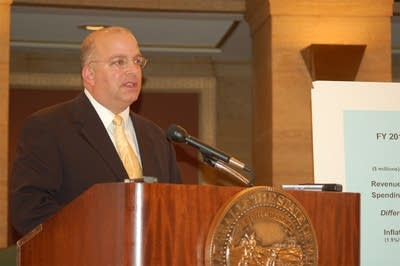Minn. officials say stimulus will ease budget pain
Go Deeper.
Create an account or log in to save stories.
Like this?
Thanks for liking this story! We have added it to a list of your favorite stories.

The state's budget situation is more uncertain today than it was yesterday. The Pawlenty administration and state lawmakers are working to determine how much aid the state will receive from the federal stimulus bill.
Here's what we do know. The money will ease some of the state's budget problems, at least in the short term, but not all of them.
"It will be very helpful," said Tom Hanson, commissioner of the Minnesota Management and Budget Department.

Hanson said the stimulus provides money for nearly every state program including transportation projects, social services and clean drinking water. In addition, Hanson said Minnesota could receive more than $2 billion to help erase the state's deficit.
Turn Up Your Support
MPR News helps you turn down the noise and build shared understanding. Turn up your support for this public resource and keep trusted journalism accessible to all.
But that money comes with strings attached. Most of it will be targeted to prevent cuts to schools. Another big portion will pay for Minnesota to maintain health insurance coverage for the working poor.
The problem for Hanson and state lawmakers is determining exactly how the money can be spent.
Gov. Pawlenty and state lawmakers have to erase a nearly $5 billion budget deficit that could grow much larger when the next revenue forecast is released on March 3.
The governor put $920 million in his budget as a rough estimate of the stimulus money the state would get. Hanson said that amount will get bigger and will provide relief.
"At best, this will be a band-aid. It will not stop the bleeding of the structural funding problems that we have in Minnesota."
"This is not an ordinary time. We have thousands and thousands of people without work. The state's revenues are declining. We have car dealerships closing," said Hanson. "The federal money will give us the opportunity to accept federal assistance and push it out into our state, to help as many people as possible."
Hanson added that Gov. Pawlenty will have to restore some of the spending cuts he proposed in order to maximize money in the stimulus package. He said as many as $200 million in cuts could be restored.
Most notable is a plan to eliminate adults from MinnesotaCare, a state subsidized health insurance program for the working poor.
Hanson said it's unlikely the governor will make those budget changes until the next revenue forecast is released. Hanson acknowledged that the federal stimulus money will only add to Pawlenty's use of one-time money to erase the budget deficit. That concerns some DFL lawmakers.
"At best, this will be a band-aid. It will not stop the bleeding of the structural funding problems that we have in Minnesota," said DFL Senate Majority Leader Larry Pogemiller.
Pogemiller said he's concerned that Pawlenty is fixing the state's budget problem by using one-time money and payment shifts. Pogemiller said the federal money is needed, but Pawlenty and the Legislature still need to create a better budget plan.
"This is very helpful in terms of bridging, and maybe protecting some things in the short term," he said. "But almost none of this federal money helps us with our structural deficit problem. Some might, but almost none of it. So this does not help us on the basic math of our structural problem."
Neither Pogemiller's DFL caucus nor the House DFL caucus have presented their budget plans yet. They plan to hold "listening sessions" next week to gather advice on the best way to solve the state's budget problems.
DFL House Speaker Margaret Anderson Kelliher said she plans to hold regular hearings to determine how the federal stimulus money is being spent, and if it's being spent wisely.




